MENUMENU
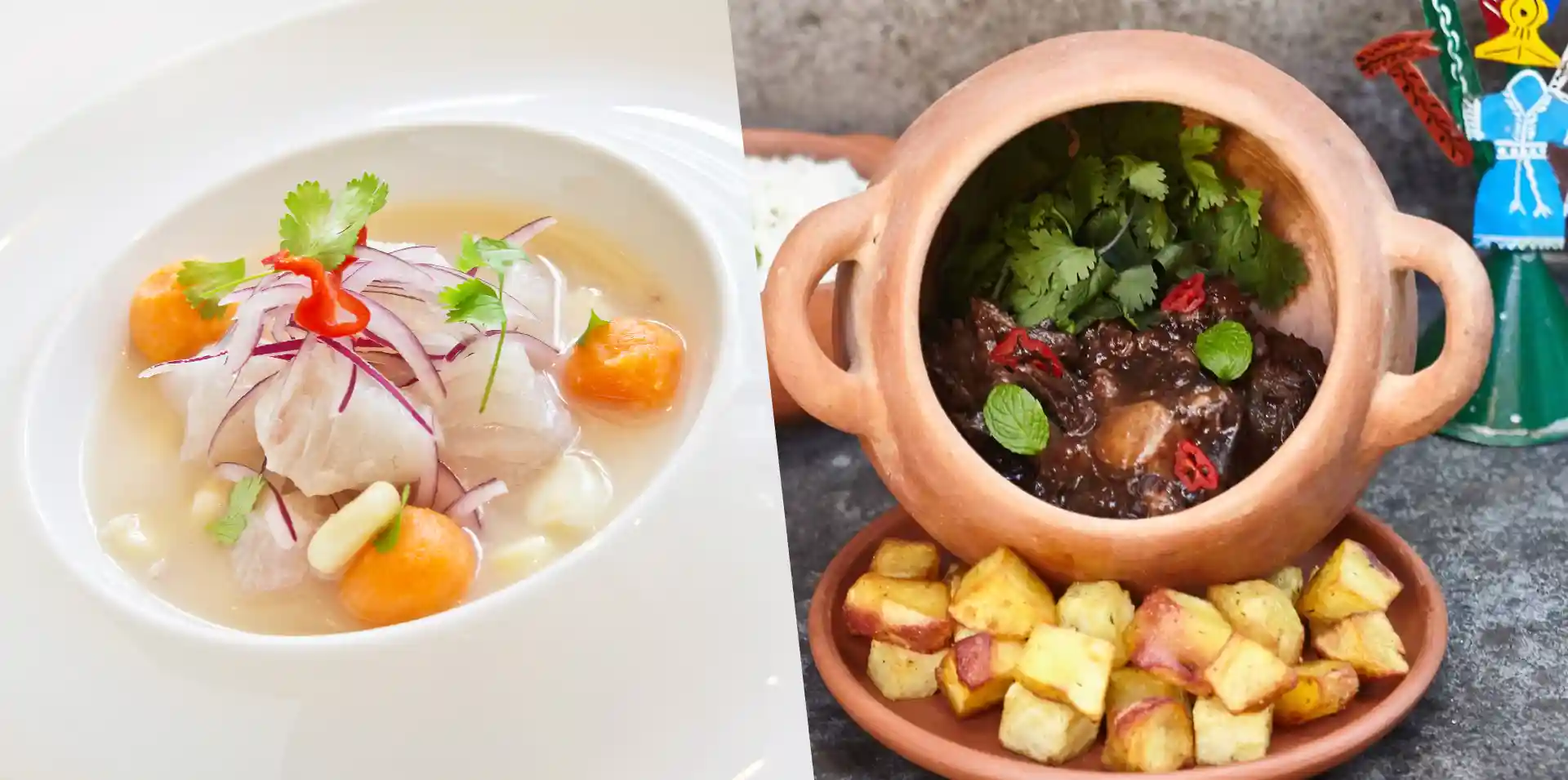
Reading time: 7 mins
Peruvian dishes feature a unique blend of flavors and ingredients that has transformed Peru into one of the top gastronomic destinations in the world. Peruvian food represents the combination of various cultures and traditions. Indigenous recipes passed down through generations have been reimagined and transformed thanks to the influence of Asian-, European-, and African-inspired dishes brought to Peru by generations of immigrants. As such, many describe Peruvian gastronomy as a textbook example of fusion cuisine.
Peru has something for everyone, providing distinguished dishes from both land and sea. One of the most important highlights of any trip can be the food. And South American destinations are no exception. These are the top 10 dishes you should try on your trip to Peru!
Ceviche, also spelled cebiche, typically consists of seafood marinated in lime or other citrus juices. These two base ingredients are accompanied by slices of onion, salt, pepper, and some chili to intensify this combination of flavors. To enhance the experience, the Peruvian recipe is served with toasted corn (corn nuts) and sweet potato.
Different variations of ceviche can be found across on the best South American countries to visit, but Peruvian-style ceviche is probably the most famous and emblematic dish on offer. Many recipes include other kinds of seafood such as shrimp and octopus. You can commonly find these variations in the coastal region, like in the capital city of Lima.
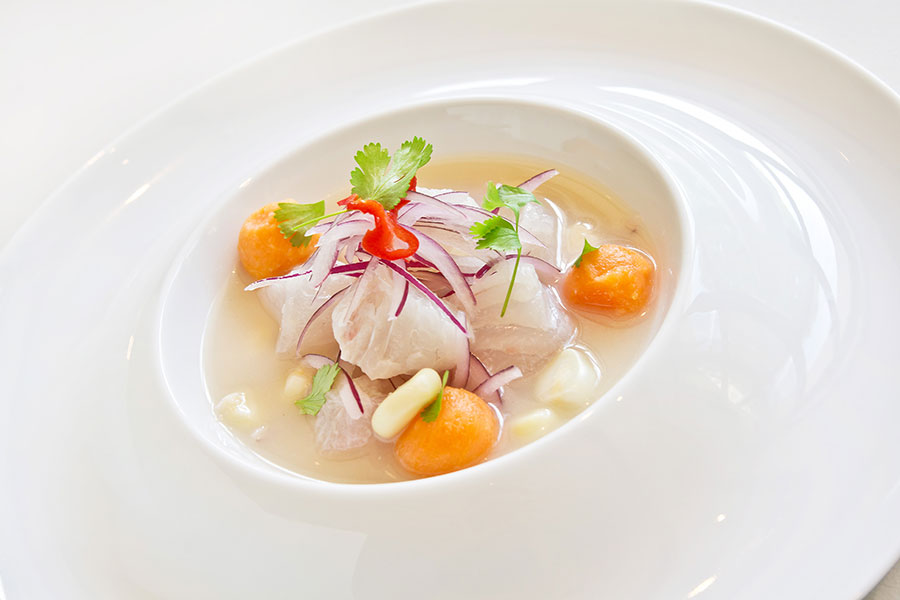
Iconic gastronomy, peruvian ceviche
Lomo saltado is strips of beef stir-fried with onions, soy sauce, yellow chili pepper, and spices served with french fries. The dish is a clear example of fusion cuisine combining traditional Peruvian ingredients with Asian techniques, creating what is commonly referred to as chifa.
The great influx of Chinese immigrants in Peru brought with them some popular cuisine from Asia that would soon gain wide popularity, contributing to everyday diets. You won’t have trouble finding lomo saltado since it is a traditional Peruvian food Peru, available in most restaurants.
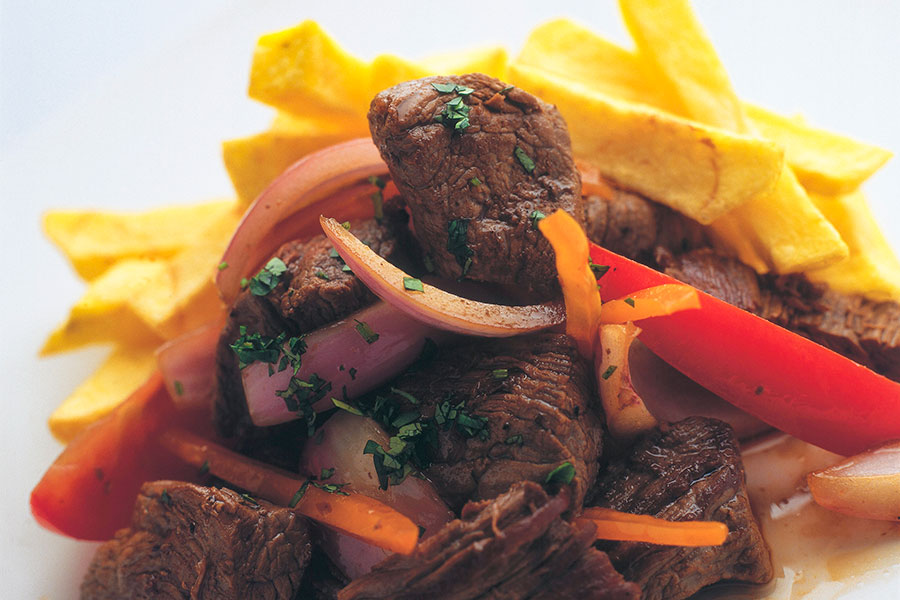
Lomo Saltado, peruvian cusine
Cuy is a South American guinea pig, a type of rodent, in other cultures is kept as a household pet. However, in many South American countries, it is often raised as livestock for human consumption. Cuy can be prepared in many ways: fried, grilled, or roasted. The dish is acclaimed for its soft dark meat under a crispy outer layer. It can be quite mouthwatering. In the Andean region, it is often the most common livestock since it is easier to breed and raise in mountainous conditions. Therefore, Cusco is the perfect place to try this singular representative of Peruvian food.
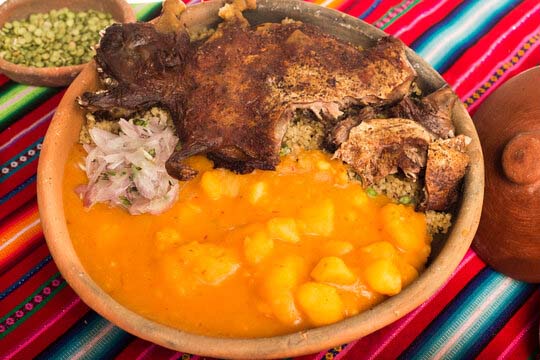
Peruvian-style Cuy
Tacu tacu is a combination of cooked and seasoned rice with beans, topped with a fried egg. The dish is a mixture of African and Peruvian cultures, being a prime example of Creole cuisine. Tacu tacu is one of the most versatile of Peruvian dishes. Different recipes mix the two base ingredients—rice and beans—with different spices, sauces, and herbs. It is served with a variety of side dishes that can include seafood, meat, or plantain. You will find variations of this dish in different restaurants. So, it might be worth trying more than once.
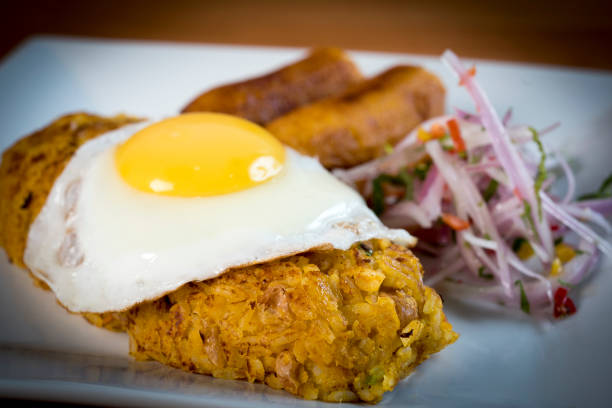
Tacu Tacu
Causa is often described as a potato casserole with layers of yellow mashed potatoes typically combined with chili pepper and lime juice. Between the top and bottom layers of this mashed potato mixture, you will find white meat, most commonly tuna or chicken, prepared in a mayonnaise sauce, along with a layer of finely cut avocados and olives.
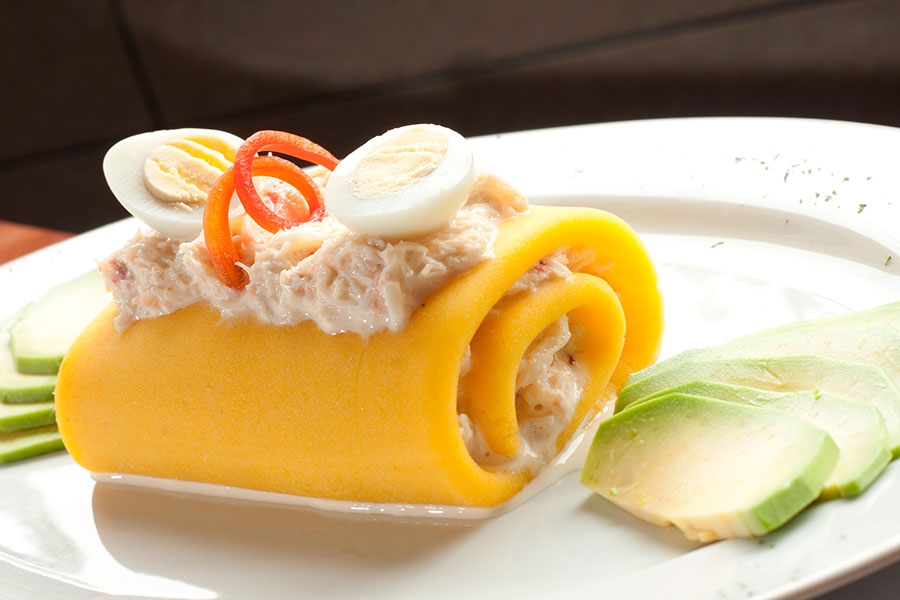
Peruvian Causa
Together with Papa a la Huancaína, it is one of the most popular cold dishes across the country. It makes for a terrific side dish, salad, or even appetizer. Its most famous variation is the causa limeña, which can be readily found in Lima.
Want to learn more about Peruvian cuisine?
Though a literal translation would be “hen chili”, Ají de Gallina is a mildly spicy chicken stew. Shredded chicken is cooked with garlic, onions, walnuts, yellow chili peppers, and turmeric, giving it a golden yellow glow. A creamy sauce is a favorite accompaniment since it is not too spicy and can be easily adapted to any taste. You will find it served with rice, olives, parsley, hard-boiled eggs, and slices of potato. Taken from European cuisine, Peru reinvented the dish and made it a staple of its stellar cuisine.
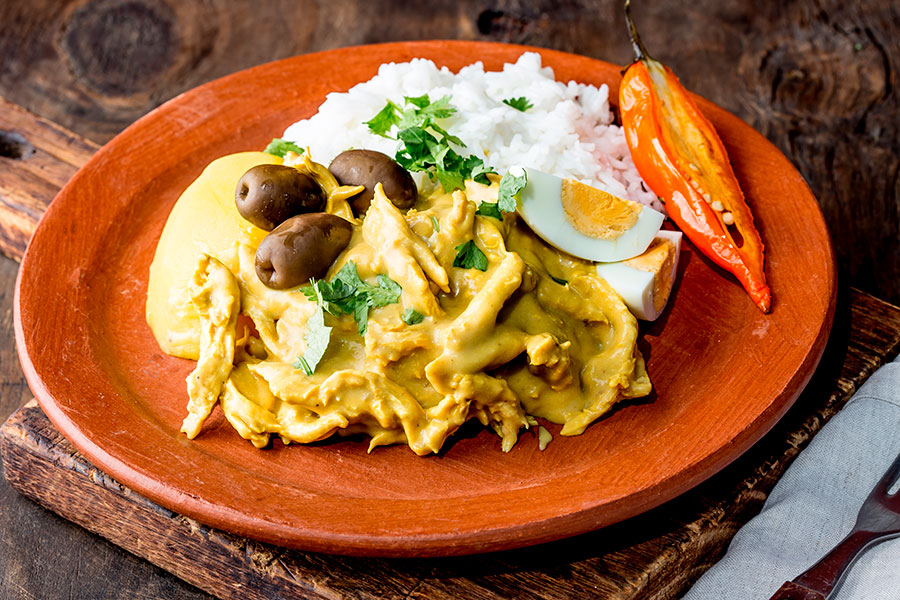
Spicy meals, ají de gallina
This rather simple dish is a favorite in both coastal and Andean regions. It consists of two main components: boiled potatoes and the famous huancaína sauce. The latter is a thick and slightly spicy cheese sauce prepared with yellow chili peppers and garlic. It is often served over a bed of lettuce, accompanied by boiled eggs, olives, and a parsley garnish. It is usually offered as an appetizer, making it a great option to share with family or friends before moving on to the main course. This common appetizer can be found in most restaurants serving typical Peruvian dishes.
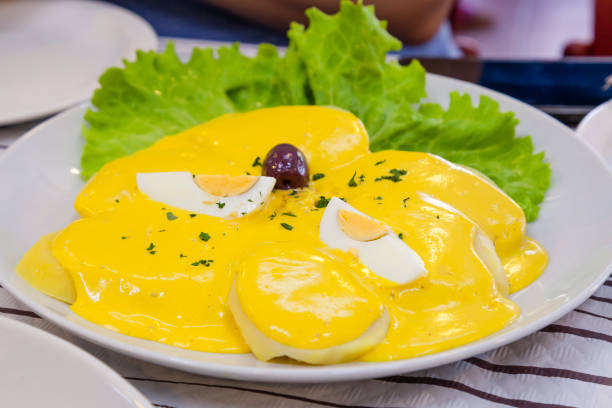
Papa a la Huancaína, a vegetarian option
Rocoto is a hot red pepper from the Andes. As the name of the dish indicates, the pepper is filled (relleno) with multiple ingredients like ground beef, cheese, and vegetables. The components of the filling merge into a single flavor as the pepper is baked in an oven. If you are looking for a spicy option, this is a great choice!
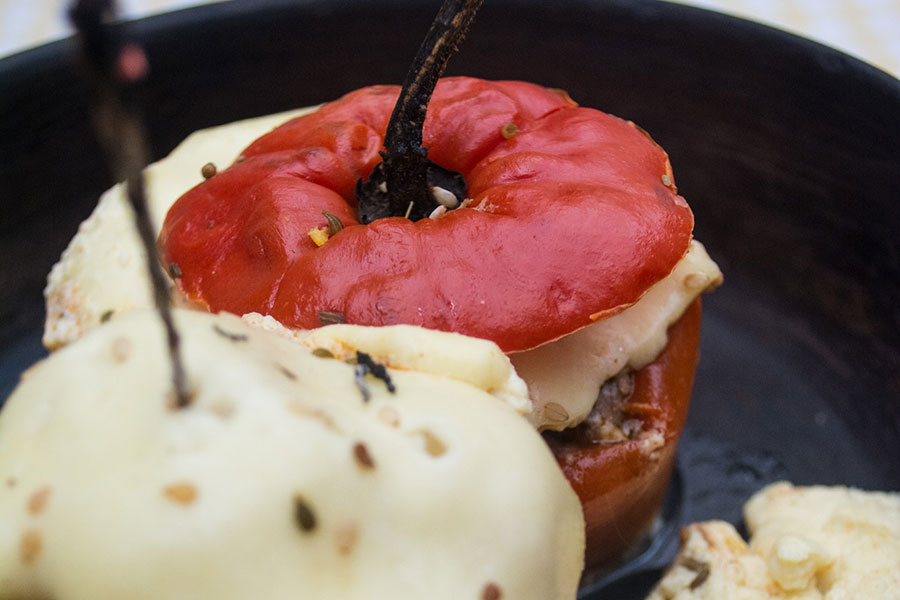
Rocoto relleno
According to local legend, a man named Manuel Masías made a pact with the Devil to get his daughter back. In exchange for his daughter’s soul, the Devil demanded a dish that would satisfy him. And so, Masías created rocoto relleno. The best place to try rocoto relleno is Arequipa, the city where this dish originated.
If you enjoy ceviche, chances are, you’ll love tiradito! Thinly cut slices of raw fish are served cold with a leche de tigre (tiger’s milk) an emulsion prepared with lime juice, chili sauce, onion, ginger, and garlic. Unlike ceviche, the sauce is elegantly placed over fresh, raw fish right before the dish is served. A sprinkle of sea salt (or crystal salt) over the fish and a cold serving plate are key in preventing the fish from cooking in the acidity of the tiger’s milk. The delicacy of the dish allows you to appreciate the freshness of every ingredient.
Tiradito is a delicious exemplar of Nikkei tradition—a type of fusion cuisine that combines the Japanese culinary experience with Peruvian ingredients. Therefore, the dish is often described as Peruvian sashimi. Lima and other coastal cities have some of the best tiraditos.
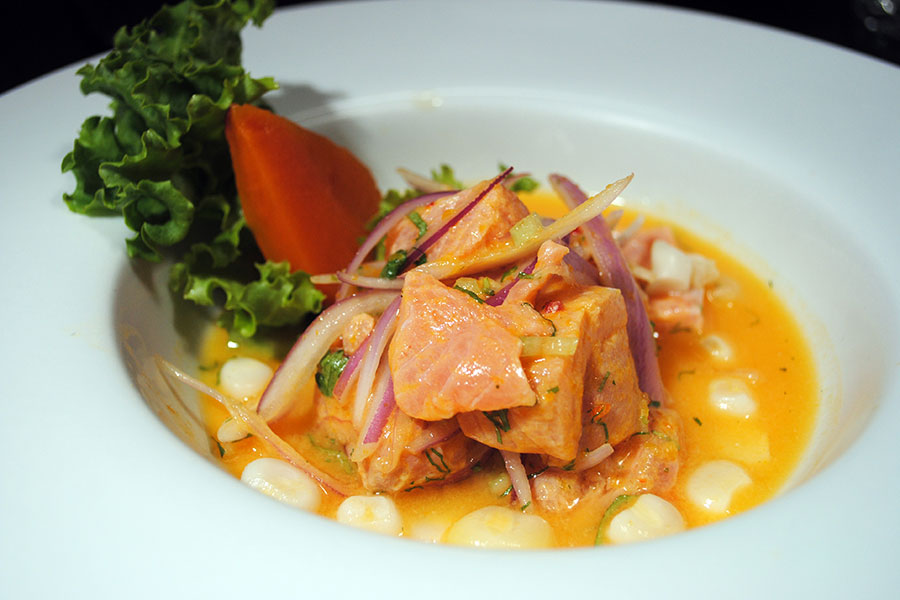
Peruvian seafood, Tiradito
Carapulcra is a pork stew cooked with peanuts, potatoes, chili, and spices. Probably the most ancient dish in the list dating back to native Inca and Aymara cuisine. What makes Carapulcra unique is the process used to dehydrate the potatoes, giving the dish a new taste and texture. Over the years it was transformed gaining influence from African cuisine, resulting in the present-day recipe. It is a common dish in Peruvian homes, and a perfect way to immerse oneself in the culture and history of the country.
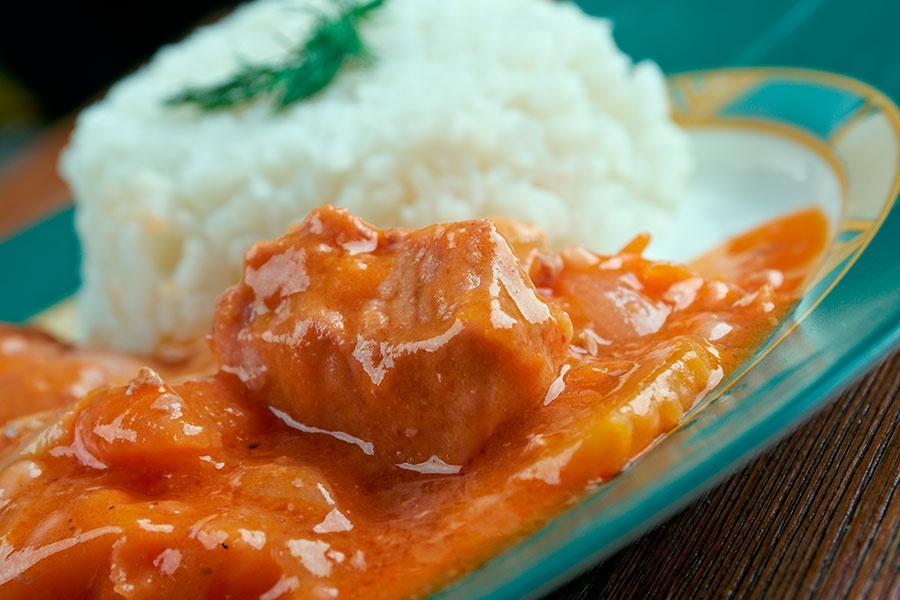
Carapulcra
Peru’s gastronomy reflects the amplitude of its rich multicultural heritage. It is filled with a wide variety of flavors and ingredients combined in very singular ways. Even though many menu items may be unknown to you, don’t be afraid to step out of your comfort zone and try new dishes.
You don’t want to miss out on one of the top culinary destinations in the world! There are plenty of Peruvian dishes to choose from.